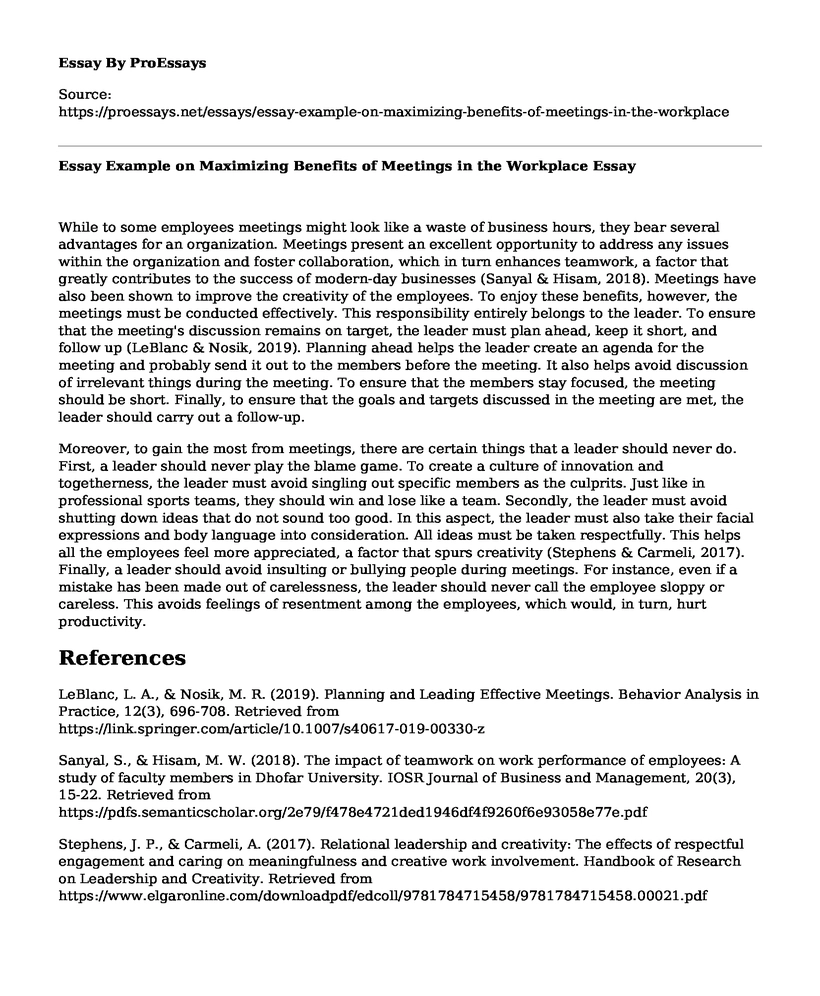While to some employees meetings might look like a waste of business hours, they bear several advantages for an organization. Meetings present an excellent opportunity to address any issues within the organization and foster collaboration, which in turn enhances teamwork, a factor that greatly contributes to the success of modern-day businesses (Sanyal & Hisam, 2018). Meetings have also been shown to improve the creativity of the employees. To enjoy these benefits, however, the meetings must be conducted effectively. This responsibility entirely belongs to the leader. To ensure that the meeting's discussion remains on target, the leader must plan ahead, keep it short, and follow up (LeBlanc & Nosik, 2019). Planning ahead helps the leader create an agenda for the meeting and probably send it out to the members before the meeting. It also helps avoid discussion of irrelevant things during the meeting. To ensure that the members stay focused, the meeting should be short. Finally, to ensure that the goals and targets discussed in the meeting are met, the leader should carry out a follow-up.
Moreover, to gain the most from meetings, there are certain things that a leader should never do. First, a leader should never play the blame game. To create a culture of innovation and togetherness, the leader must avoid singling out specific members as the culprits. Just like in professional sports teams, they should win and lose like a team. Secondly, the leader must avoid shutting down ideas that do not sound too good. In this aspect, the leader must also take their facial expressions and body language into consideration. All ideas must be taken respectfully. This helps all the employees feel more appreciated, a factor that spurs creativity (Stephens & Carmeli, 2017). Finally, a leader should avoid insulting or bullying people during meetings. For instance, even if a mistake has been made out of carelessness, the leader should never call the employee sloppy or careless. This avoids feelings of resentment among the employees, which would, in turn, hurt productivity.
References
LeBlanc, L. A., & Nosik, M. R. (2019). Planning and Leading Effective Meetings. Behavior Analysis in Practice, 12(3), 696-708. Retrieved from https://link.springer.com/article/10.1007/s40617-019-00330-z
Sanyal, S., & Hisam, M. W. (2018). The impact of teamwork on work performance of employees: A study of faculty members in Dhofar University. IOSR Journal of Business and Management, 20(3), 15-22. Retrieved from https://pdfs.semanticscholar.org/2e79/f478e4721ded1946df4f9260f6e93058e77e.pdf
Stephens, J. P., & Carmeli, A. (2017). Relational leadership and creativity: The effects of respectful engagement and caring on meaningfulness and creative work involvement. Handbook of Research on Leadership and Creativity. Retrieved from https://www.elgaronline.com/downloadpdf/edcoll/9781784715458/9781784715458.00021.pdf
Cite this page
Essay Example on Maximizing Benefits of Meetings in the Workplace. (2023, Apr 05). Retrieved from https://proessays.net/essays/essay-example-on-maximizing-benefits-of-meetings-in-the-workplace
If you are the original author of this essay and no longer wish to have it published on the ProEssays website, please click below to request its removal:
- Recruitment Methods and Interview Questions
- Genre Analysis of a Professional Email Essay
- Paper Example on Nursing Career
- Assignment Example on Time Management
- Essay Sample on Management Information Systems (MIS)
- Essay Example on Internet Use in the Workplace: Analyzing the Ethical Implications
- Confidential Agreement: Leadership Behaviors Stimulating Positivity - Dissertation Example







